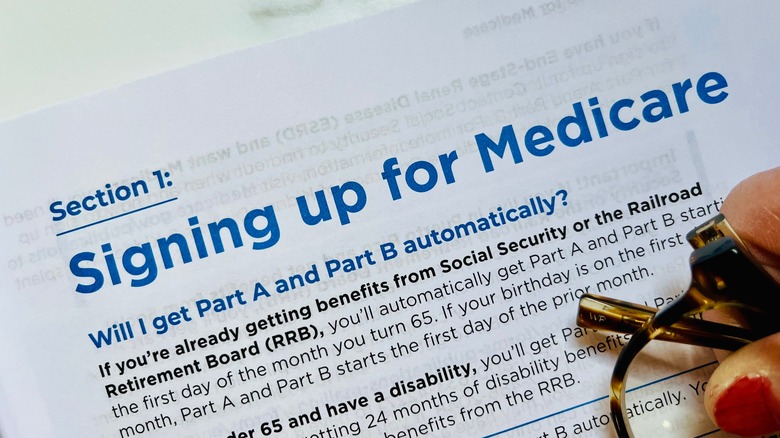Retirees Should Avoid These Medicare Mistakes At All Costs
Medicare is one of the largest social insurance systems in the United States, providing coverage to 69 million people. Established in 1965, the program is designed to provide healthcare to retirees and some disabled individuals. Although there are different subprograms to consider, Medicare generally covers a wide array of routine medical needs such as doctor and specialist appointments, hospital visits, preventive care, and drug prescriptions. Enrollees can even receive compensation for nursing homes or hospice care, demonstrating the extent of the coverage. Medicare coverage is usually free at the point of service, but everyone contributes to the system via payroll taxes throughout their lifetime.
Despite widespread enrollment and general support, Medicare is often viewed as unnecessarily complicated and suffering from limited coverage. About 71% of enrollees, according to one study, aren't happy with their benefits, and 68% are confused about parts of their plans. The social program recently turned 60 years old and is likely to continue for many decades down the road. However, there are plenty of ways that enrollees can improve their experience with the system for optimized financial coverage, ease of access, and fewer financial headaches. As with many things, what you don't do is nearly as important as what you do. Avoiding these common Medicare mistakes can help set you up for success when navigating this complicated program.
Assuming all plans are the same
Medicare is the official name of the federal insurance system, but it's an umbrella term encapsulating several different subprograms. If you've ever heard of Medicare broken down by letters, such as Parts A, B, C, and D, you're already obliquely familiar with the sections. Let's break it down further, since aligning your needs with each program's specific offerings is essential to get the best coverage while saving valuable time and money.
Part A is responsible for hospital coverage, including at-home care, hospital visits, nursing homes, and hospice care. Part B is medical insurance, accounting for preventive care, such as vaccine schedules and health screenings, doctor appointments, and outpatient care. Part C, more commonly referred to as Medicare Advantage, is a privately-run add-on that offers different combinations of the other Medicare plans. This additional coverage tends to come with extra costs. Prescription coverage falls under Part D. Retirees should consider all options before enrolling in Medicare after turning 65. However, once isn't enough. With plan coverages and your health needs constantly shifting, it's vital to reevaluate your options during open enrollment. Avoid putting your Medicare on autopilot for better coverage and lower costs.
Misunderstanding enrollment periods
Late enrollment could be one of the unexpected reasons your first Medicare bill is so high. Similar to private insurance policies, Medicare has strict enrollment periods during which people must sign up for the program. Missing these crucial deadlines could mean delayed coverage, out-of-pocket costs, and even financial penalties. The first registration period kicks off three months prior to the month an individual reaches retirement age. Once you hit 65 years old, this Initial Enrollment Period (IEP) endures for three months. That means the program gives people over half a year to complete all the paperwork and pick a program once they enter retirement.
Retirees who miss this primary intake period may be left to their own devices for healthcare coverage, putting their nest egg at risk of cracking early on. Fortunately, that's not the only enrollment window provided by the program. Medicare has a General Enrollment Period (GEP), lasting between January 1 and March 31 of every year, when current recipients reenroll. Retirees who failed to enroll during the IEP should take advantage of this opportunity. While most people fall into these two admission cycles, some retirees qualify for various Special Enrollment Periods (SEPs). Instead of a 65th birthday or a certain calendar date, these enrollment phases are triggered by life events, such as moving.
Ignoring important changes
Medicare has been a bedrock government program for decades, but it's always changing. For example, who is eligible to enroll and at what age coverage begins have all evolved. Similar to private health insurance coverage, recipients are responsible for understanding how public programs evolve to ensure their healthcare needs are accounted for appropriately. Misunderstanding or outright ignoring these developments might cost you dearly in coverage gaps, higher-than-expected premiums, or severely limited benefits.
Unfortunately, some of the worst changes to Social Security have happened in the past few years, and many people are sounding the alarm bells about Medicare. Some of the most unpopular and controversial shifts include nearly half a trillion dollars in potential cuts over the next 10 years, according to the Center for American Progress, and increasing attempts to privatize the program, which has been fully publicly funded since its inception. Not all Medicare changes are costly to enrollees, though. For example, Plan D recipients no longer have to share any of their healthcare costs after reaching a $2,000 out-of-pocket cap.
Picking a plan that doesn't cover your doctor or drugs
Medicare is not a set-and-forget program. Not only do constant changes demand that enrollees remain vigilant, but every subprogram differs in coverage. It's exceedingly rare to find a program that provides the full spectrum of benefits to fit your healthcare needs. One of the Medicare mistakes retirees should avoid at all costs is picking a program with insufficient coverage. Ensuring the plan includes the doctors you see routinely and the medications you take regularly can help shift the financial costs onto the program rather than them landing squarely on your shoulders.
The Medicare website advises retirees to speak with their providers about what's known as "accepting assignment." This means a doctor or specialist accepts Medicare coverage for the full cost. Speaking directly with providers is one of the most direct ways to ensure they're within your program's coverage. If you're wondering what kind of prescriptions are covered under Part D, the Centers for Medicare & Medicaid Services has a handy prescriber look-up tool that searches a broad database of providers. You can search by location or name.
Copying your spouse's Medicare plan
Researching different Medicare plans, comparing various coverage options, and mapping those onto your medical needs is a time-consuming process. To simplify things, many retirees will simply sign up for the same plan as their spouse. This shortcut might save you a headache in the short term, but it can cost you financially in the long run. Plan D coverage seems to be where people make this mistake most commonly. In fact, an
found that 70% of couples opt for the same Plan D prescription plan regardless of the overall costs.
Furthermore, the report suggests that retired couples who use the same plan spend $690 more on average annually. That overpayment stretches to $1,000 in some cases, underscoring the financial costs of copy-pasting a program. Part D involves the coverage of prescription drugs, so it's designed to be custom-fit for each individual. Medicare makes it easy by providing retirees with a plan finder that will offer specific suggestions based on their unique needs. With almost half of retirees running out of money, saving every dollar in your golden years is crucial.
Thinking that employer insurance is primary coverage
More retired individuals remain in the workforce than at any point in the country's history, opening up the risk of medical coverage gaps. Some employed senior citizens assume their employer-sponsored insurance program takes precedence over Medicare. In reality, according to AARP, many companies list their coverage as secondary, meaning coverage only kicks in after Medicare does. This supplemental structure keeps costs low for businesses by putting the financial burden on the social program and, in many cases, working seniors.
This is most common among smaller companies with only a few dozen employees. When you reach retirement age — 65 years old — even if you're not retiring, you need to be clear about how you or your spouse's private insurance coverage changes. Once you become eligible for Medicare, your coverage and associated costs could shift dramatically. Without Medicare as a backstop, you could be filling in the gap out of pocket before your work insurance ever gets triggered. The IEP is the best time to figure out these changes.
Ignoring dental and vision coverage
Medicare provides decent healthcare benefits to tens of millions of retirees, yet the social program has two massive blind spots: dental and vision. These crucial services are mostly uncovered by Parts A and B, often referred to as Original Medicare. While dental and vision services as part of broader emergency services, such as a surgery or hospital visit, could be covered, Medicare generally doesn't touch routine care in these areas. Assuming your healthcare is provided for these services can lead to some surprise bills. These aren't fringe or uncommon issues, either. According to the Ophthalmology Times, about 25% of individuals over 71 have vision impairment. Furthermore, 96% of retirees suffer from tooth decay, as the Senior Citizens League reports.
Despite these being common problems among retirees, Original Medicare simply refuses to offer coverage due to funding restraints and solvency concerns. However, retirees can skirt surprise healthcare bills for vision and dental by getting coverage through Medicare Advantage or Part C. Benefits from these private policies vary based on where you live and what kind of coverage you need, but it's better than getting smacked with an unforeseen bill due to vision or dental issues.
Disregarding the Annual Notice of Change (ANOC)
Retirees receive some seriously helpful free healthcare benefits from Medicare, yet these offerings are in constant flux. To help recipients remain abreast of these changes, the program provides an Annual Notice of Change (ANOC). This letter outlines any changes to an individual's coverage for the upcoming year that could impact their out-of-pocket expenses and healthcare benefits. If you're a current enrollee, you should receive the ANOC in September. The modifications noted are often scheduled to take place in January of the upcoming year. Reading this annual notice can help you save time and hassle in the long run, disputing otherwise unknown changes.
These three months should be used to cross-reference your new plan's coverage range with your healthcare needs for the year, along with your financial situation. From a cost perspective, the most important areas of the ANOC to review are your overall out-of-pocket costs, monthly premiums, and copay amounts for doctor or hospital visits. This document will also break down how your prescription drug coverage changes under Part D and what providers are still included. Healthcare coverage is one of the most important expenses retirees shouldn't forget about, and the ANOC is an annual roadmap to preparing for optimal coverage and minimal costs.
Choosing coverage based solely on premiums
When reviewing Medicare plans, the premium is where many retirees shift their focus. It's the same with standard private health insurance programs. Understandably, people place a lot of weight on their monthly costs. After all, healthcare isn't one of those bills retirees should rethink immediately; it's indispensable. Finding the perfect balance between financial manageability and required benefits is a prudent move. However, honing in on premiums when choosing a plan risks overlooking other costs that come with Medicare. Additional expenses to consider include deductibles, coinsurance, and copays — all of which can raise how much you spend annually on Medicare coverage.
Still confused about these costs? Let's break them down. A premium is the total monthly cost for coverage. You're paying whether or not you receive services. Most people don't pay a premium for Part A since those funds come from tax contributions. However, Parts B, C, and D tend to have premiums. Copayment refers to a set amount you'll pay alongside a provider for services included in Medicare. A deductible is the total expenses you'll pay before Medicare coverage kicks in. Finally, coinsurance is a certain percentage of the overall expenses that enrollees pay.
Forgoing financial help
There's a common misconception regarding the costs of Medicare, with many retirees assuming the coverage is free. As mentioned before, Plan A is the only component that's free at the point of service because the vast majority of enrollees contributed to the program while in the labor force. While premiums and deductibles can add up, retirees want to avoid the costly mistake of assuming that there's no financial assistance available. Many states offer specific programs for residents to help make Medicare-related costs more manageable.
Beyond these state-level programs, there are also supplemental Social Security and Medicaid programs for those in lower-income brackets. Overlooking this fact could keep you from getting the coverage you need while eating into your retirement savings more than necessary. You're better off reviewing financial aid options instead of signing up for coverage you might be able to afford. Make sure to consider your options far in advance of enrollment periods to account for the extra time required to apply for financial assistance. Unlike student loans, which can actually help with your retirement goals, much of this Medicare aid doesn't need to be repaid.
Assuming everything is covered
Retirees sometimes mistakenly assume that their medical expenses are fully covered throughout their golden years, minus a few charges here and there. In reality, there are many Medicare payment gaps that people should be aware of to avoid surprise costs. As previously discussed, most benefits related to dental and vision aren't offered by the social insurance program. However, that's not where Medicare's coverage gaps end.
Surprisingly, long-term hospital stays and extended care services are usually not covered or are only funded for a set period. This is a vital mistake to avoid at all costs since retirees would have to pay for 100% of these long-term care expenses, which could deal a serious blow to their financial stability, especially considering the lifespan of these costs. If you find yourself faced with the need for extended health coverage, Medicaid could offer more coverage. Medigap is another supplemental option offered by private companies to bridge the gap between what Medicare doesn't traditionally cover and what seniors need.
Leaving a high-income surcharge in place
High-earning Medicare enrollees in Parts B and D may have to pay a surcharge on top of their premiums. Known as an income-related monthly adjustment (IRMAA), this add-on cost can significantly drive up premium costs. In 2025, individuals earning more than $106,000 or couples taking in more than $212,000 together will have to pay this monthly premium. Instead of a flat rate, this extra cost is calculated by looking at a recipient's Modified Adjusted Gross Income (MAGI) — a calculation of a person's taxable income. Notably for retirees, this doesn't just cover earning money through standard work contracts. It can include standard financial moves that a retiree would make, such as withdrawing from a retirement account, selling stocks, or receiving pension payments from a prior employer.
Having enough money to retire rich is wonderful, but you won't want to trigger this premium if you can avoid it. Furthermore, if your income has dropped below the threshold and you're still paying the surcharge, you might be able to knock down your premiums. All you have to do is appeal the payments to Medicare directly. Some major life events that can trigger a sudden and serious drop in income include leaving the labor force, dropping from full to part-time, getting a divorce, or losing a spouse. Officials will most likely ask for substantive proof of your income fluctuation, so having those documents ready can help improve your chances of getting the premium waived.
Not looking into coverage abroad
There are plenty of attractive countries to retire in outside the United States, but most retirees are perfectly content with spending their golden years at home and traveling abroad sporadically. As is the case with many private insurance programs, Medicare offers almost no coverage outside of the U.S. Whether you're taking a short jaunt or spending longer periods out of the country, you need to clarify any coverage gaps and make sure to fill them before leaving. To be clear, Medicare defines "outside the U.S." to refer to any place that's not the 50 states and Washington D.C., along with U.S. territories such as Northern Marian Islands, American Samoa, Guam, U.S. Virgin Islands, and Puerto Rico.
There are three exceptions to this general rule of Medicare not offering healthcare benefits to enrollees when they're in foreign countries. Whether you're having a medical emergency or need to visit the hospital and the nearest hospital is in a third country, not the U.S., Medicare could offer coverage. Another exception is if you experience a medical emergency when traveling on a direct route between Alaska and the U.S. through Canada. All other foreign trips would require additional travel insurance if you want sufficient coverage.













